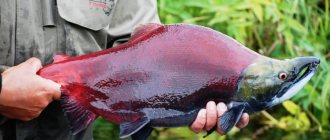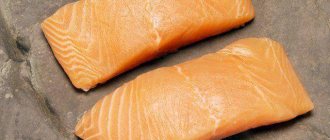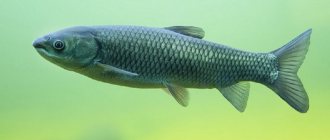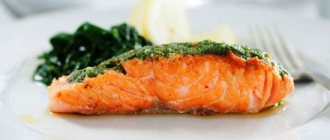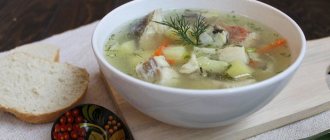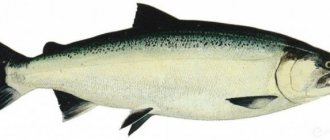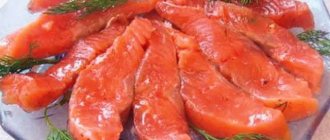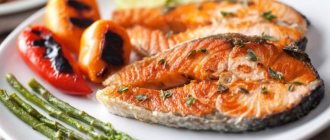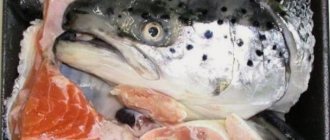What kind of fish is Chinook salmon and where does it live?
The individual is distinguished by its outstanding size, which determines its name. Chinook salmon is also called royal or princely salmon. Fish is popular due to the following factors:
- gastronomic qualities;
- active resistance during the fishing process.
Chinook salmon, which belongs to the Salmon family, are characterized by an anadromous lifestyle. It includes distinct fluvial and oceanic phases.
In fresh water conditions the following processes occur:
- spawning;
- caviar development;
- hatching of fry;
- growing juveniles.
It is noteworthy that maturation, development of reproductive function, and weight growth are observed in the marine environment. The lifespan of Chinook salmon ranges from 4 to 8 years. This is due to the pre-spawning period. Within two weeks, individuals that take part in spawning die.
King salmon are found in the following waters:
- Arctic Ocean basin;
- Seas of Okhotsk and Barents;
- Commander Islands;
- Sacramento.
In recent years, artificial breeding of Chinook salmon has been practiced on specially built farms.
The fish adapts well to water of any salinity. However, the development of eggs occurs only in cool flowing rivers that have a rocky or pebble bottom.
Chinook salmon are distinguished from other representatives of the salmon family by their significant weight. The average individual reaches 6-17 kg. The length of the fish varies and is 1.5-2 m.
Chinook salmon has the following external characteristics:
- compressed sides;
- small eyes;
- long body (torpedo-shaped);
- big mouth;
- small scales;
- true and adipose fins;
- black gums of the lower jaw;
- chaotic spots on the body and tail.
Appearance, such as color, is determined by the life phase. Typically, Chinook salmon have the following color scheme:
- silver sides;
- olive or greenish-blue back;
- white belly.
We recommend reading: Milkfish (hanos): benefits, how to cook, where it is found
During the mating season, the fish acquires burgundy shades and large teeth. It is noteworthy that males have slightly curved jaws.
The spawning period begins in June and ends in August. Fish can travel thousands of kilometers to reach a place with optimal conditions.
The life cycle includes several stages:
- appearance in a freshwater environment and life for two years;
- moving at sea;
- return to the places of birth (after five years).
During the period of residence in rivers, Chinook salmon feed on:
- larvae;
- small fish and crustaceans;
- insects.
After moving to the sea, king salmon eat:
- plankton;
- cephalopods;
- krill;
- crustaceans.
Important! The variety received a scientific description at the end of the 18th century. The name is associated with the language of the peoples of Kamchatka.
Description and features of fish
In the specialized literature you can find various names for this fish. Thus, American fishermen often call it king salmon, and Japanese fishermen - the prince of salmon, all this speaks of the undoubted commercial value of chinook salmon. The distinctive features of the sea dweller include the following:
- Impressive size. The average weight varies from 5 to 18 kg, however
- Some lucky fishermen managed to catch specimens weighing up to 30 kg. And the recorded record figure is more than 60 kg.
- The length of the fish is also impressive - from 80 cm to 2 meters. The body is powerful, top-shaped. The head is large. It is interesting that muskyling, a representative of pikes, can also grow to similar sizes.
- Between the body and head of the Chinook salmon there are large dark stripes, which also distinguishes it from other salmon.
- The color is determined by the environmental conditions in which the fish lives. It can be either olive or light gray, with a greenish tint or silver.
- There are dark spots on the back, sides, caudal and dorsal fins. At the same time, the pink stripes characteristic of other salmon are absent on Chinook salmon. This way you can distinguish it from salmon and salmon.
Life expectancy is short, rarely exceeding 7 years. At 3 years old, females become sexually mature and ready to spawn.
Habitat
Such large fish are found both in the seas and in fresh waters, and their diet largely depends on where exactly they live. Thus, in fresh water bodies, Chinook salmon stop eating plankton, squid and fry, switching to river crustaceans and larvae.
It is customary to identify several main areas where fish are found:
- Coast of the USA. It was here that it was possible to catch record holders among Chinook salmon in size.
- Kamchatka and the Kuril Islands of Russia. There are a lot of fishing spots here, a visit to which will bring you a rich catch.
- The Japanese islands, namely their northern part.
Freshwater populations are found in the Amur and Anadyr basins, as well as in individual reservoirs of British Columbia. It is now common to create so-called fish farms, where Chinook salmon are raised under artificial conditions. In particular, such breeding is present in New Zealand and the USA.
Life cycle specifics
Red Chinook salmon goes through several stages of its life cycle, periodically moving from fresh waters to sea waters and back. Thus, it hatches from eggs only in freshwater bodies of water, where it lives until it reaches two years of age. Next, the fish moves to the seas, where it will live for up to 3-5 years, feeding on the local fauna. To spawn, it returns to fresh water again, and can travel a distance of more than 4 thousand km.
Spawning itself is a rather lengthy process; it can last from June to August, and in more northern areas - from autumn to winter. Reproduction occurs only once in a lifetime, and due to the serious hormonal changes that occur in the body of males, many fish do not live to see 7-8 years.
It is interesting that the first description of the largest salmon was found in 1701, when V. Atlasov, visiting Kamchatka, was struck by the impressive size of the red fish, which looked very similar to salmon. Catching Chinook salmon is quite difficult, since it is a very cunning species that prefers to rest in places that are difficult for anglers to reach.
Therefore, its price is high - about 400-500 rubles. for 1 kg. You can buy it both at retail outlets and in specialized VKontakte groups created by experienced fishermen. Smoked fish is even more expensive, its cost often exceeds 1,500 rubles.
Composition of Chinook fish
The meat is red in color with a hint of crimson. The valuable product is rich in protein (20 g per 100 g). The fat ratio is 13%. The energy value of meat is 146 kcal. The presence of Omega-3 fatty acids, which are not produced by the human body, is essential.
Important! PUFAs improve metabolic processes.
The caviar has a unique composition and is bright red in color. The product is characterized by a large size, reaching 7 mm. The delicacy is valued for its rich taste and thin shell. A feature of the product is its rapid digestibility.
Meat and caviar are rich in the following valuable substances:
- PUFAs (polyunsaturated fatty acids);
- antioxidants;
- amino acid tryptophan;
- B vitamins;
- ascorbic acid;
- cholecalciferol;
- tocopherol;
- phosphorus;
- iron;
- calcium;
- sodium;
- magnesium;
- potassium.
Beneficial properties of Chinook salmon caviar
Regular consumption of meat and caviar has a beneficial effect on the body. Including this product in your diet allows you to:
- strengthen the nervous system and bone tissue;
- reduce the risk of developing Alzheimer's disease, sclerosis;
- normalize the functioning of the heart and blood vessels;
- improve blood circulation;
- ensure adequate functioning of the visual organs;
- remove harmful substances from the body.
Eating fish, as well as king salmon caviar, helps saturate the body with valuable nutrients
How to cook better
King salmon tastes like salmon. However, chinook salmon is less fatty and has a low calorie content, which is 150 kcal (per 100 g). Fish is included in the diet menu. Royal salmon is salted, boiled, steamed, stewed, baked and canned. The product can be added to salads and snacks. Preserving the original appearance during the cooking process is essential.
We recommend reading: Rapan: composition, calorie content, benefits and harm to the body
Chinook salmon is valued for its excellent taste and healthy qualities. The lightly salted product is popular. To preserve valuable components, the fish is subjected to shock freezing.
Nutritional value and taste
Raspberry-red Chinook meat tastes like salmon, but contains less fat - from 10 to 13%. Chinook salmon is superior in quality to many salmon species.
100 g of product contains:
- proteins – 18.3 g;
- fat – 4.3 g;
- saturated fat – 0.9 g;
- carbohydrates – 0 g;
- dietary fiber – 0 g;
- kilocalories – 117.
Smoked chinook salmon is also rich in vitamins (B6, B5, B12, D, PP) and minerals (phosphorus, copper, selenium and choline, the presence of which promotes phospholipid metabolism in the liver).
It is believed that fish meat is eaten even raw, but nothing compares to the taste of smoked Chinook salmon. This fish makes excellent balyk and very tasty smoked fillet.
Contraindications and possible harm from fish
The dietary product is good for health. In rare cases, allergic reactions may occur. If undesirable effects occur, it is not recommended to consume both caviar and king salmon meat. Contraindications also include the presence of chronic diseases of the digestive tract.
Chinook salmon brings both benefits and harm to the body. Caviar should be consumed in limited quantities. This is due to the increased sodium content, which can lead to stagnation.
Important! It is advisable to exclude Chinook salmon caviar from the diet of pregnant and lactating women due to the ability of the fish to accumulate mercury.
How to choose and store fish correctly
The value of Chinook salmon depends on the fishing period. The optimal time for fishing is considered to be the period before the king salmon ascends the river. The most useful individuals are those that were not raised in an artificial environment. This is due to the absence of a significant amount of harmful substances.
When choosing chinook salmon, it is advisable to give preference to relatively small-sized fish. It contains fewer toxic components. To preserve all valuable nutrients, so-called shock freezing is carried out. It is usually performed after catching Chinook salmon. Care must be taken to prepare and consume the product within the recommended shelf life.
Hot smoked Chinook salmon
To prepare hot smoked chinook salmon, you can use a barbecue apparatus, a medical mixer, homemade devices, or large pans. However, the most aromatic delicacy will be obtained if you choose a smokehouse for the hot method. Such devices cost much less than for cold smoking, and you can even order them via the Internet.
The most convenient way to smoke chinook salmon is to fillet it. Then you won’t have to constantly worry about thick pieces not being sufficiently saturated with flavor. After all, the fish carcasses are large, and it is extremely difficult to cook it completely in a regular smokehouse.
Ingredients! For salting, you can take a mixture of peppers, salt, a little coriander or other seasonings to taste. But the most correct option for red fish is regular salt. It is enough to obtain the desired aroma.
So, let’s start cooking and marinating:
- The fillet pieces together with the skin are cut into 2–4 pieces depending on the size of the fish.
- Sprinkle the pieces with medium-ground salt on top and add ground black pepper to taste.
- Salted chinook salmon is placed in a container or on a plate, covered with another plate for 1 hour.
- Then the fish is wiped and hung to dry for another 1–2 hours in a place protected from flies.
- Now we begin to prepare the smokehouse. Many gourmets recommend soaking the wood chips, while others recommend not doing this. The best way to choose the right solution is to try both methods yourself.
- You can choose alder chips or sawdust from fruit trees. If you choose the soaking option, then leave the wood for 30 minutes in a container of water.
- A fire is lit in the grill. When the wood burns out, put the soaked wood chips in the smokehouse at the very bottom. Place a tray on top to collect fat, and a grate on top of it, greased with vegetable oil. If there is no tray, then you can put 2-3 layers of foil on the wood chips, leaving gaps around the edges for the smoke to escape.
- Cover the fish with a lid and place on the fire. When white smoke starts, time it for 25–30 minutes.
The finished fish needs to sit in the fresh air for at least half an hour for the aroma and taste to intensify!
